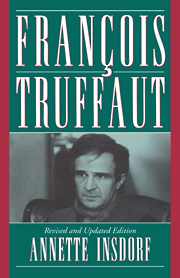Book contents
4 - “Are Women Magic?”
Summary
Beautiful Lies
TO THE QUESTION posed by numerous males in Truffaut's films, we can add, “are women mad?”, “are women vulnerable?”, “are women more complex than the men assume?” The answer to all of these is yes, for Truffaut has created a rather bizarre gallery of rich female portraits. It is impossible to generalize about the women from Les Mistons through Confidentially Yours, for they can be as repellent as attractive, as destructive as warm, as absolutist as adaptable, and as inclined toward madness as love. Truffaut's awareness that a multiplicity of selves inhabits even one woman is evident in the “doubling” that is characteristic of his work. There are films that center on a male protagonist, whose own needs lead him to embrace two complementary female figures: Theresa/Lena in Shoot the Piano Player, Franca/Nicole in The Soft Skin, Linda/Clarisse (played by the same actress) in Fahrenheit 451, Christine/Fabienne in Stolen Kisses, Christine/Kyoko in Bed and Board, and Anne/Muriel in Two English Girls. And there are films that devote more attention to one female psyche with (at least) two manifestations: Catherine in Jules and Jim, Julie/Marion in Mississippi Mermaid, Julie/Pamela in Day for Night, Adèle/“Madame Pinson” in The Story of Adèle H.
Moreover, if we see Truffaut's work as a whole, another pair is formed by Julie Kohler (Jeanne Moreau) in The Bride Wore Black (1968) and Camille Bliss (Bernadette Lafont) in Such a Gorgeous Kid Like Me (1972), both of whom display no less than five personalities—one for each of their admirers.
- Type
- Chapter
- Information
- François Truffaut , pp. 105 - 144Publisher: Cambridge University PressPrint publication year: 1995



